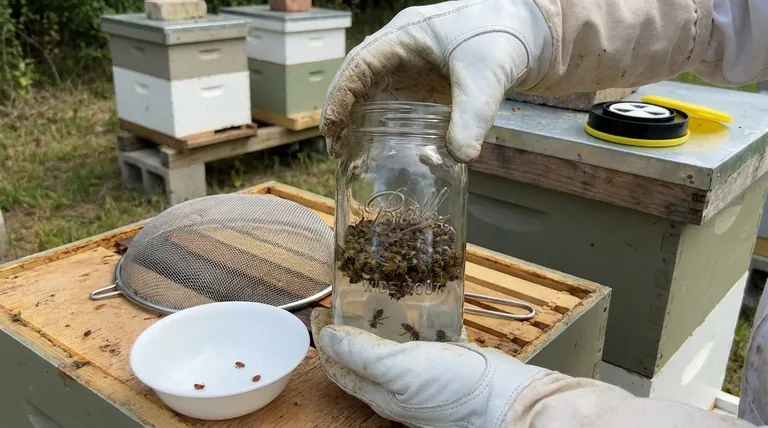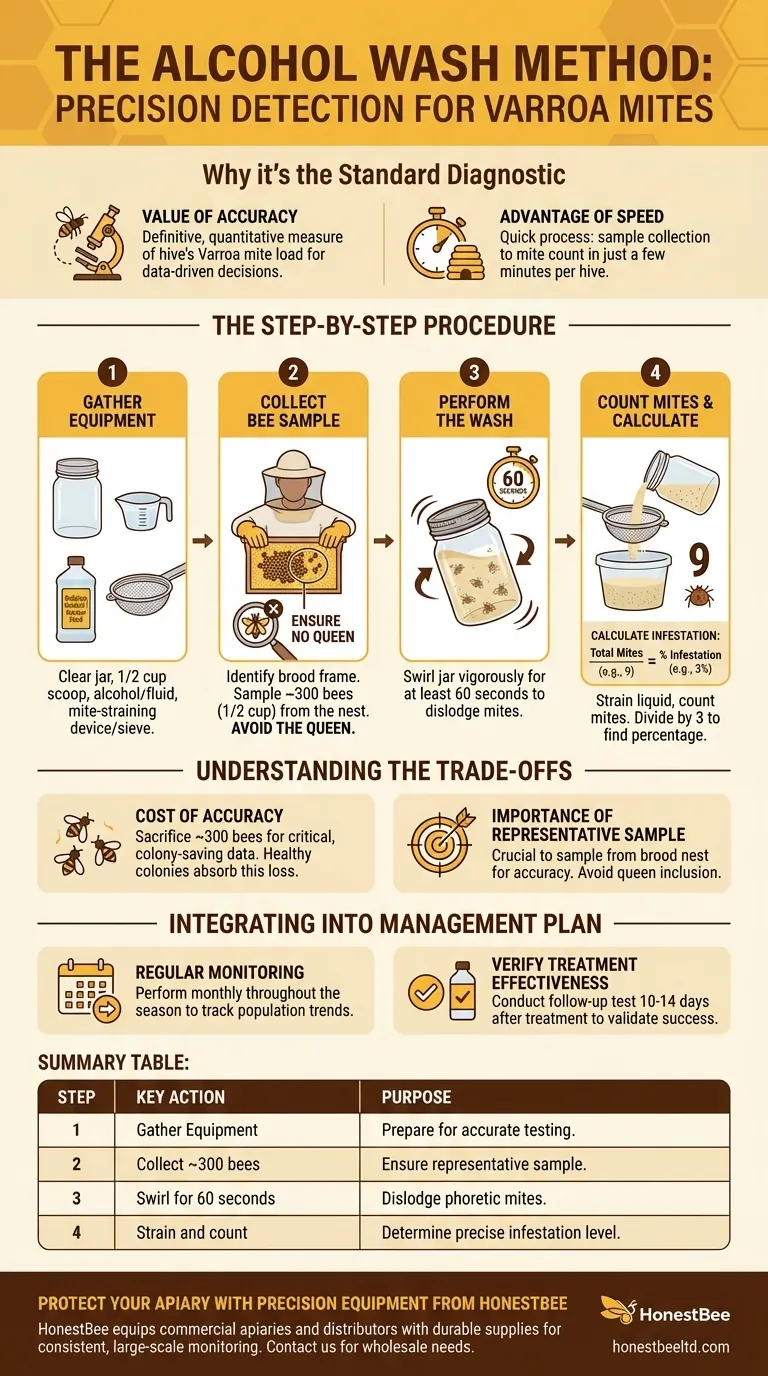To perform an alcohol wash, you collect a sample of approximately 300 bees from the brood area, ensuring the queen is not included. These bees are then submerged in a jar half-filled with rubbing alcohol or windshield washer fluid. After swirling the jar for one minute to dislodge the Varroa mites, you strain the contents to separate the bees, allowing you to count the mites left in the liquid and accurately calculate your colony's infestation level.
The alcohol wash is a highly accurate diagnostic tool, not just a casual check. It provides a definitive, quantitative measure of your hive's Varroa mite load, empowering you to make critical, data-driven decisions about treatment.

Why the Alcohol Wash is a Standard Diagnostic
The primary purpose of monitoring Varroa mites is to know when intervention is necessary. The alcohol wash method is favored by many beekeepers and researchers for its reliability and speed.
The Value of Accuracy
An alcohol wash provides one of the most accurate snapshots of the phoretic mites—those found on adult bees—in your colony.
This accuracy allows you to compare your mite levels directly against established treatment thresholds, removing guesswork from your hive management.
The Advantage of Speed
Once you have your equipment ready, the entire process from sample collection to mite count can be completed in just a few minutes per hive.
This efficiency makes it practical for beekeepers with any number of colonies to conduct regular, consistent monitoring.
The Step-by-Step Procedure
Executing the test correctly is critical for obtaining reliable results. Follow these steps precisely for each colony you test.
Step 1: Gather Your Equipment
You will need a clear jar with a lid (a standard quart or pint jar works well), a 1/2 cup measuring scoop, and a container with at least one cup of rubbing alcohol or winter-grade windshield washer fluid.
You will also need a mite-straining device, which can be a purpose-built tool or a simple jar with a #8 hardware cloth (eight squares per inch) screen for a lid.
Step 2: Collect the Bee Sample
Identify a frame from the brood nest that is well-covered with bees, as this is where mite concentrations are highest.
Carefully inspect the frame to ensure the queen is not present. Once confirmed, collect approximately 300 bees (a level 1/2 cup) by gently scooping them into your measuring cup and quickly dumping them into your jar of alcohol.
Step 3: Perform the Wash
Secure the lid on the jar and swirl it vigorously for at least 60 seconds. This agitation, combined with the alcohol, is what dislodges the mites from the bees' bodies.
Step 4: Count the Mites and Calculate
After swirling, pour the liquid and mites through your sieve into a clear, light-colored container, leaving the bees behind in the jar.
Carefully count the Varroa mites in the strained liquid. To find your infestation rate, divide the number of mites by 3 (since you sampled ~300 bees) to get the percentage of mite infestation. For example, 9 mites in a 300-bee sample equals a 3% infestation rate.
Understanding the Trade-offs
While highly effective, the alcohol wash method has one significant trade-off that every beekeeper must consider.
The Cost of Accuracy
This method requires sacrificing the ~300 bees in your sample. The bees are killed by the alcohol during the test.
However, a healthy colony can easily absorb this small loss of population. The critical data gained from the test is considered far more valuable than the bees sacrificed, as it can save the entire colony from a fatal mite infestation.
The Importance of a Representative Sample
The accuracy of your test depends entirely on the quality of your sample. Failing to take bees from the brood nest can give you a falsely low reading.
Likewise, accidentally including the queen would be a devastating blow to the colony. Diligence during the collection step is non-negotiable.
Integrating the Wash Into Your Management Plan
An alcohol wash is not a one-time event; it's a recurring part of a proactive hive health strategy.
Establish a Regular Monitoring Schedule
You should perform an alcohol wash on your colonies regularly throughout the season, ideally on a monthly basis.
This creates a clear picture of how your mite populations are trending, allowing you to anticipate problems before they become critical.
Verify Your Treatment's Effectiveness
After applying a mite treatment, an alcohol wash is the best way to confirm it worked.
Conduct a follow-up test 10 to 14 days after the treatment period ends. This validates that the treatment was successful and your mite levels are now below the acceptable threshold.
Making the Right Decision for Your Colony
Using this data correctly is the key to proactive and successful beekeeping.
- If your primary focus is routine monitoring: Perform monthly alcohol washes to track mite population dynamics and treat only when infestation rates cross established economic thresholds.
- If your primary focus is post-treatment validation: Use an alcohol wash two weeks after treatment to ensure your investment of time and money was effective and the colony is safe.
Ultimately, the alcohol wash method provides the clarity needed to protect your bees from their most significant threat.
Summary Table:
| Step | Key Action | Purpose |
|---|---|---|
| 1 | Gather Equipment (jar, alcohol, sieve) | Prepare for accurate testing. |
| 2 | Collect ~300 bees from brood nest | Ensure a representative sample for reliable results. |
| 3 | Swirl bees in alcohol for 60 seconds | Dislodge phoretic mites from the bees. |
| 4 | Strain and count mites; calculate percentage | Determine precise infestation level (mites counted / 3 = %). |
Protect Your Apiary with Precision Monitoring Equipment from HONESTBEE
Accurate Varroa mite testing is the cornerstone of effective Integrated Pest Management (IPM). The alcohol wash method provides the definitive data you need to make critical, colony-saving decisions.
HONESTBEE equips commercial apiaries and beekeeping equipment distributors with the durable, reliable supplies required for consistent, large-scale monitoring. Our wholesale-focused operations ensure you get the high-quality jars, sieves, and other essentials you need to implement this vital diagnostic tool across all your hives.
Stop guessing and start knowing your mite levels. Contact HONESTBEE today to discuss your equipment needs and build a proactive defense for your bees.
Visual Guide

Related Products
- Adjustable Formic and Acetic Acid Dispenser for Bee Mite Treatment
- Professional Dual-End Stainless Steel Hive Tool for Beekeeping
- Professional 3-Bar Frame Grip with Integrated Hive Tool
- HONESTBEE Advanced Ergonomic Stainless Steel Hive Tool for Beekeeping
- JZBZ Push-In Queen Cell Cups for Beekeeping
People Also Ask
- What are phoretic mites? A Beekeeper's Guide to Monitoring Varroa Infestation
- How can beekeepers ensure their hives survive the winter? A Guide to Colony Survival
- What is the optimal time for varroa mite control in nucs? Maximize Efficacy with Perfect Timing
- What should be done after treating a colony for varroa mites? A Step-by-Step Guide to Verifying Success
- How do Varroa mites spread between honey bee colonies? Stop Mite Transmission in Your Apiary



















